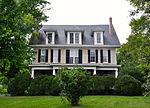Mooreland (Brentwood, Tennessee)
Greek Revival houses in TennesseeHouses in Williamson County, TennesseeNational Register of Historic Places in Williamson County, TennesseeResidential buildings completed in 1838Williamson County, Tennessee Registered Historic Place stubs

Mooreland is a property in Brentwood, Tennessee that was built c.1838 and that was listed on the National Register of Historic Places in 1975. It was built by Robert Irvin Moore and includes Greek Revival architecture.It is one of about thirty "significant brick and frame residences" surviving in Williamson County that "were the center of large plantations " and display "some of the finest construction of the ante-bellum era." It faces on the Franklin and Columbia Pike that ran south from Brentwood to Franklin to Columbia.
Excerpt from the Wikipedia article Mooreland (Brentwood, Tennessee) (License: CC BY-SA 3.0, Authors, Images).Mooreland (Brentwood, Tennessee)
Centerview Drive,
Geographical coordinates (GPS) Address Nearby Places Show on map
Geographical coordinates (GPS)
| Latitude | Longitude |
|---|---|
| N 36.029444444444 ° | E -86.788333333333 ° |
Address
Hilton Garden Inn Nashville Brentwood
Centerview Drive 217
37027
Tennessee, United States
Open on Google Maps




